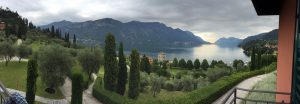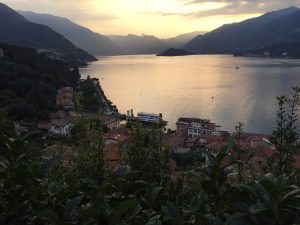
This is not a holiday snapshot, it’s actually a photograph from the balcony of one of my recent workshop venues – the Bellagio Center, in Bellagio, Italy, on the shores of Lake Como.
I had long heard of this venue, but my first visit was only recently, for a scoping meeting of an interesting new social enterprise initiative called Sphaera (the subject of a future blog post).
Some groups hold their workshops a short walk down the hall from their offices. Some go a little off site to a nearby hotel or conference centre, not wanting to have to go too far to gather their participants together but wanting something a little different for a change of context. And yet others put a lot of effort into finding just the right gathering spot that will help participants bring their best and most relaxed and creative selves to the task at hand. Even if it means a little extra time and travel to get there.
Environment definitely affects people’s ability to work effectively and creatively. I have been to many workshops held in square, grey institutional rooms looking out at parking lots (if they had windows) that took a heroic effort on everyone’s part to get inspired and energised for a hard working session to develop their new partnership, strategic plan, or vision. When the food is so-so, and the bed rooms are so-so, added to weather or logistics hassles, no matter how well structured your event is, you are starting on the back foot with your people.
Now come with me to Bellagio, Italy for a moment – a visual feast every moment of the day (even in the rain), with cozy villa rooms to sleep and work in, served meals that always start with drinks in the drawing room or on the balcony. Winding lanes, vast gardens and olive trees to walk and talk, 24-hour coffee nooks, and bikes to borrow to follow signs to the swimming gate for before or after-hours exercise. Far from any large, noisy urban area (although gelati within a short walk) there is not a sound at night that can disturb deep sleep. What’s not to love?
I pulled out three immediately obvious benefits from working in a peaceful and beautiful place:
- Presence: It is often hard for busy people working 150+ percent to stop the noise in their brains long enough to focus on your agenda and goals, even if they have a vested interest. If they are close to home or their offices, they tend to disappear from time to time, or try in all the breaks keep up as much as possible with their full-time work load. Give them a magical place to work and shorten that transition time from crazy busy to creative. They will be present not only physically, but mentally because where they are with you for work is better than almost anywhere else they could be. They will still try to keep up on email in the evenings at least for the first day or so, but there will be a lot to get and keep their attention here.
- Pace: Sequestered as we were in villas that were over 500 years old, watching sailboats o the lake float by, walking up and down the hill to our meetings and meals, hearing the lazy buzz of bees on banks of flowers, a beautiful ruin of a castle reminding you of the slow march of time – things slow down dramatically in a place like this. With your focus on the one thing you are there to do together, your pace slows down dramatically – from the full throttle dash to keep up or catch up through frenetic full-time multi-tasking, to a measured, considered and thoughtful cadence (aah, so this is what life should be like).
- People: So now with your head up (rather than on your screen) and in an awe-inspiring environment, you begin to notice those people around you, also attending your meeting. You have time for them, and wonderful places to get to know them. You enjoy the beauty of the place together, you sit in the garden for your small group discussion with your shoes off and your bare feet on the grass, the sun just starting to set over the top of the villa. You remember that drinks are being served in 30 minutes on the terrace and you finish your discussion on creative ways to bring more learning into the process under discussion.
People are comfortable in this venue, they smile and laugh easily and before your very eyes, people are connecting, relationships are being built, and there is a desire to collaborate and co-create. Nice! (I just got a big rush of peaceful and productivity just looking at these photos and remembering my week at Bellagio.)






